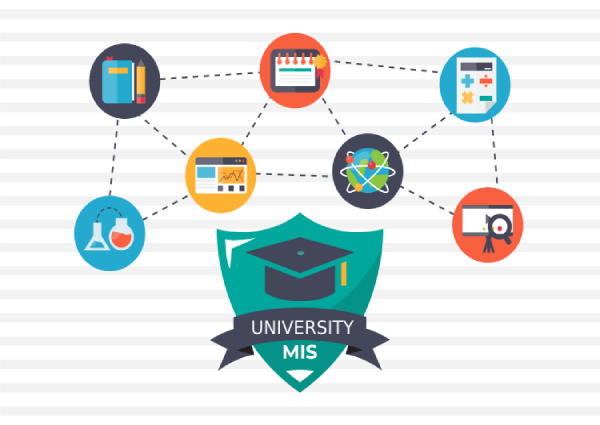Office Address
د دارالامان کوڅه
کابل، افغانستان
Phone Number
+۹۳ ۷۸۷ ۶۱۱۲ ۷۱
د دارالامان کوڅه
کابل، افغانستان
+۹۳ ۷۸۷ ۶۱۱۲ ۷۱

MIS په ځانګړي ډول د لوړو زده کړو موسسو لپاره جوړ شوی. دا د پوهنتون د عملیاتو د ټولو اړخونو اداره کولو لپاره د مرکزي پلیټ فارم په توګه کار کوي، د زده کونکو د داخلې څخه تر پوهنځي مدیریت، د نصاب پلان جوړونې، او هاخوا.
توضیحات
MIS په ځانګړي ډول د لوړو زده کړو موسسو لپاره جوړ شوی. دا د پوهنتون د عملیاتو د ټولو اړخونو اداره کولو لپاره د مرکزي پلیټ فارم په توګه کار کوي، د زده کونکو د داخلیدو څخه تر پوهنځي مدیریت، د نصاب پلان جوړونې، او هاخوا.
دلته اصلي ځانګړتیاوې دي:
د زده کونکو مدیریت:
داخلیدل او نوم لیکنه: د غوښتنلیک سپارلو څخه تر نوم لیکنې تایید پورې د داخلې ټوله پروسه اتومات کوي.
د زده کونکو ریکارډونه: د زده کونکو جامع پروفایلونه ساتي پشمول د شخصي معلوماتو، اکاډمیک تاریخ، او غیر نصابي فعالیتونو.
د حاضرۍ تعقیب: د زده کونکو د حاضرۍ اسانه تعقیب او راپور ورکولو ته اجازه ورکوي، د ټولګي مدیریت سیسټمونو سره یوځای کول.
اکاډمیک مدیریت:
د کورس مدیریت: د کورسونو رامینځته کول، تعدیل او ګمارنه اسانه کوي، پشمول د مخکینیو او شریکو اړتیاو.
د مهالویش مهالویش: د غوره شوي ټولګي مهالویشونه رامینځته کوي، د زده کونکو او پوهنځي دواړو لپاره شخړې کموي.
د ازموینې او درجه بندي: د خوندي درجې ننوتلو او راپور ورکولو سره د ازموینې مهالویش، اداره او درجه بندي پروسې ساده کوي.
د پوهنځي مدیریت:
د پروفایل مدیریت: د پوهنځي مفصل پروفایلونه ذخیره کوي، پشمول د وړتیاو، خپرونو، او تدریس تاریخ.
د کار د بار مدیریت: د پوهنځي د کاري بارونو څارنه او اداره کول، د تدریس او اداري مسؤلیتونو متوازن ویش ډاډمن کول.
د فعالیت ارزونه: د پوهنځي د ارزونې ترسره کولو لپاره وسایل چمتو کوي، د زده کونکو نظرونه او د ملګرو بیاکتنې شاملوي.
اداري مدیریت:
د بشري سرچینو او معاشاتو رول: د بشري سرچینو او معاشاتو عملیات اداره کوي، د وخت او دقیق معاشونو توزیع ډاډمن کوي.
مالي او بودیجه: د مالي پلان جوړونې، د بودیجې تخصیص، او د لګښتونو تعقیب ملاتړ کوي، د مالي شفافیت لوړول.
د اسانتیا مدیریت: د پوهنتون د تاسیساتو ساتنه او مهالویش څارنه کوي، پشمول د ټولګیو، لابراتوارونو او آډیټوریمونو.
اړیکه او همکاري:
د خبرتیا سیسټم: د مهمو تازه معلوماتو او ضرب الاجلونو لپاره زده کونکو، پوهنځي او کارمندانو ته اتوماتیک خبرتیاوې او خبرتیاوې لیږي.
د همکارۍ وسیلې: د زده کونکو او پوهنځي ترمنځ د همکارۍ لپاره پلیټ فارمونه چمتو کوي، پشمول د فورمونو، چیټ خونو، او د پروژې مدیریت وسیلو.
راپور ورکول او تحلیل:
د معلوماتو تحلیل: د اکاډمیک او اداري معلوماتو څخه د بصیرت رامینځته کولو لپاره د تحلیل ځواکمن وسایل وړاندې کوي، د معلوماتو پر بنسټ پریکړې کولو ملاتړ کوي.
دودیز راپورونه: د ځانګړو اداري اړتیاوو پوره کولو لپاره د دودیز راپورونو جوړولو ته اجازه ورکوي، له اکاډمیک فعالیت څخه تر مالي روغتیا پورې.
امنیت او اطاعت:
د معلوماتو امنیت: د پرمختللي کوډ کولو او لاسرسي کنټرول میکانیزمونو سره د حساس معلوماتو امنیت او محرمیت ډاډمن کوي.
تنظیمي اطاعت: ادارو سره مرسته کوي چې د تعلیمي معیارونو او مقرراتو سره مطابقت ولري، اداري حساب ورکول ډاډمن کوي.